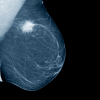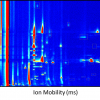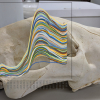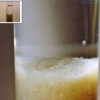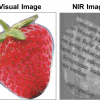J. Reeda and A.N. Daviesa,b
aSERC, Sustainable Environment Research Centre, Faculty of Health, Sport and Science, University of Glamorgan, UK,
bDirector, Analytical Laboratory Informatics Solutions
Introduction
Modern bioreactors are an excellent solution to many problems facing our society today. Anaerobic digesters, for example, not only provide a solution for the safe disposal of the mountains of waste and sludge we produce but also have the potential to provide substantial amounts of energy and fertiliser as the end products.1
The waste breakdown means that the solids content is significantly lower at the end of the process and the smells normally associated with sewage sludge are removed. They are also far cheaper to run than the equivalent aerobic digestion solutions such as composting. Recent legislation has also led to a search for other solutions to the disposal of various waste streams other than in landfill or burning.
Although the promise of this technology is clear and anaerobic digesters have been widely deployed especially across continental Europe, Mencken’s old adage “There is always an easy solution to every human problem—neat, plausible, and wrong” holds very true here. This issue’s column reports on some recent work by a multi-disciplinary team quantifying the capability of near infrared (NIR) spectroscopy in extensively and successfully getting to grips with the complex problem of optimising anaerobic digestion operation.2 To make their investigation more difficult they ruled out any sort of off-line or near-line pre-treatment of the samples and ran three bioreactors together to obtain data that could be used to see if the underlying data could be used to generate predictive and closed-loop control models that would be generally applicable rather than being restricted to the individual reactors (see Figure 1).

Defining the problem
Anaerobic digestion is, in itself, a complex multi-step process using a combination of bacteria. The reactors studied were single-stage reactors operating in semi-continuous flow mode in which at least four groups of bacteria carry out different tasks and need to be kept in balance. It is the complex equilibrium that the team were interested in measuring and monitoring with a view to assessing the feasibility of implementing more intelligent closed-loop bioreactor control mechanisms.
At a high level, the equilibria can be described as follows. Initially bacterial hydrolysis breaks down the large organic polymers to sugars and amino acids, which the acidogenic bacteria convert into carbon dioxide, hydrogen, ammonia and organic acids. The acetogenic bacteria convert the organic acids into acetic acid, ammonia, hydrogen and carbon dioxide, and methanogenic bacteria complete the digestion to methane and carbon dioxide (see Figure 2).

Reactors can be designed to run in both batch and continuous flow modes. In continuous flow reactors the operators need to balance the inputs with the capabilities of the bacteria populations to digest what they are being fed or else trouble starts—just as in humans! A typical failure of the loading control can lead to the acetogenic and methanogenic bacteria not coping with the amounts of volatile fatty acid (VFA) being presented to them by the acidogenic bacteria step. The ensuing build up of VFAs leads to a drop in the bicarbonate alkalinity (BA) and the pH further inhibiting the functioning of the methanogens. This then becomes a vicious circle leading to a collapse of the process and the death of the reactor’s microbial populations.
Existing monitoring
Currently the majority of deployed anaerobic digesters use an extremely limited set of monitoring sensors commonly logging only temperature and gas flows. Occasionally, the gas quality is measured on-site but any data on the biochemical processes themselves are restricted to lab-based digestate or reactor content sampling and measurement carried out intermittently and off-line.
This lack of reliable data on the exact state of the bioreactor, and the risks associated with tipping the equilibria of the bacterial populations into the collapse of the process, mean that normally anaerobic digesters are run very conservatively and inefficiently. If a better inline monitoring system could be proven to deliver the required performance information in a timely and robust manner these digesters could run far more efficiently and cost-effective manner with increased throughput.
Many studies have looked at anaerobic digester monitoring over the years but the complex nature of the problem with widely varying input parameters and loading rates have made it difficult to produce models that are capable of robustly following the wide variety of parameters needing monitoring if closed-loop control is to be implemented.
Near infrared spectroscopy
Near infrared spectroscopy has been reported many times in Spectroscopy Europe as a tool of choice in many analytical areas. It can be typically found working as a standard process analysis tool in the pharmaceutical and especially the food industries. Deployment in anaerobic digesters is somewhat more complicated due to the relatively low amounts of solids in the sample that has led to earlier studies concentrating on batch sampling often in association with sample drying as preparation steps before the spectroscopy is attempted. For the development of a closed-loop control, this is obviously undesirable.
Three optical geometries have been compared in the past for online measurements: transmission, transflexion and reflection. As an academic exercise, clearly, the transmission cell delivers the best results but for the matrices under investigation significant sample treatment or filtering is required. Unfortunately, if the technology is to be deployed straight into the bioreactor without altering the sample being observed it requires the reflectance probe to be used.
The study reported here looked at standard reflectance probes as the most practical solution for the environment around the anaerobic digesters and looked at bioreactor control as well as feedstock management.
The instrument deployed here was a PerkinElmer 100N spectrometer fitted with a Near Infrared Reflectance Accessory (NIRA). Samples were scanned over the range of 4000–12,000 cm–1 at 16 cm–1 resolution, 250 scans signal averaged.
The anaerobic digesters
Three 20 L scale anaerobic digesters were operated using mixtures of primary and activated sewage sludges typical of those found in the wastewater industry. The mixture of primary and waste activated sludge (WAS) was roughly 70 : 30 and the total solids ~5% after water make-up.
Reference data was obtained off-line for total solids (TS), volatile fatty acids (VFA), bicarbonate alkalinity (BA) and volatile solids (VS) and spectroscopic data collected to match the reference sampling time points. The three reactors were run for a total of 57 days.
The feedstock analysis was carried out on mixtures of primary and activated sludges but varying the proportion of primary to activated sludge from 0% to 100% whilst maintaining a total solids content of 5% (see Figure 3).

Data analysis
Principal component analysis (PCA) was carried out on the data from reactor one looking at the reactor under varying operating conditions. The reactor was started using the standard 70 : 30 primary to activated sewage sludge ratio at a safe mean organic loading rate of 2.6 g volatile solids per litre which yielded a hydraulic retention time of 15 days and a temperature of 35°C. These conditions (OC1 and OC3) were the steady-state conditions that were returned to after each perturbation (see Figure 4).

To simulate the arrival of differing feedstocks and their effect on the reactor, the loading was switched to pure activated sludge at a loading rate mean of 2.8 for days 12 and 13 and the dramatic effect can be seen in the OC2 plots in Figure 4.
The reactor was then allowed to return to steady state conditions (OC3–5: days 14–39) before perturbations effects of temperature (OC6: days 40–49) as well as loading rates and retention times (OC7: days 50–54, OC8: days 55–57) were carried out until the reactor died.
This PCA analysis clearly demonstrated the capability of NIR to follow reactor changes and therefore to be used in reactor monitoring and to provide early warning of deviations from the steady state. The ability to carry out measurements which would add to the diagnosis of problems with the reactor allowing for appropriate counter-measures to be initiated to avoid reactor failure or simply to operate the reactor more efficiently in a closed-loop control would be more useful.
To investigate if NIR spectroscopy could also operate in this role calibrations were carried out based on the spectra obtained over the 57 days from two of the reactors and the calibration reference values listed above. The partial least squares (PLS) calibrations were validated not by cross validation within the reference data sets but by full independent validation using the data from the third reactor. This gave a much better feel for the robustness and transferability of the calibrations between different bioreactor vessels.
Figure 5 shows the results of the different calibrations for the analytes under consideration as well as the model for monitoring the proportion of activated sludge.

Results and conclusions
Within the bounds of the aims of this work Figure 5 clearly shows the capabilities of NIR spectroscopy to follow the varying analyte concentrations within the bioreactor during perturbation. Figure 6 shows exactly this tracking over time for reactor one for total and volatile solids, VFAs and bicarbonate alkalinity.

Obviously, there are more accurate laboratory methods of quantitatively determining the exact concentrations of the various analytes but the validation of the models shows that it is possible to follow the trends in the concentrations of the various analytes across different reactors using the less spectroscopically favourable, but more process-applicable reflection NIR techniques. Better correlations could have been achieved by doping the samples to broaden the range of concentrations calibrated against but this would have take the reactor matrix well outside its normal operating range and as such would have only artificially enhanced the statistical data without really providing any realistic improvement of the understanding of the robustness of the method.
References
- For more information on anaerobic digestion see www.walesadcentre.org.uk/
- J.P. Reed, D. Devlin, S.R.R. Esteves, R. Dinsdale and A.J. Guwy, “Performance parameter prediction for sewage sludge digesters using reflectance FT-NIR spectroscopy”, Water Research 45(8), 2463–2472 (2011).










